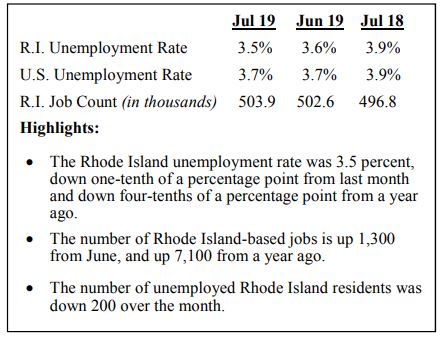PROVIDENCE – The unemployment rate in Rhode Island declined 0.4 percentage points year over year to 3.5% in July, according to the R.I. Department of Labor and Training Thursday.
The 3.5% rate was 0.2 percentage points below the national rate of 3.7% for the month. One year prior, the Rhode Island and U.S. unemployment rates were level at 3.9%.
Nonfarm employment in the state increased 1.4% over the year to 503,900 jobs. The number of employed Rhode Islanders, however, declined by 300 year over year to 533,500.
The Ocean State labor force declined 2,500 people year over year to 553,100 in July. The number of unemployed – those available for and actively seeking work – in the state was 19,600, a 10.1% decline year over year. A total of 9,481 people filed for Unemployment Insurance benefits in July, a decline from 9,779 filings one year prior.
Despite the labor force decline and decline in employed Rhode Islanders, the DLT touted the increase in Rhode Island-based jobs as a record for the state.
“[The Bureau of Labor Statistics] estimates Rhode Island-based jobs reached 503,900 last month – a record high for our state, and our unemployment rate fell below the U.S. rate for the second consecutive month,” said DLT Director Scott Jensen in a statement. “We need to continue investing in our greatest asset: Rhode Islanders to continue building a resilient economy.”
Employment by sector (in descending order of total employment):
- Health care and social assistance employed 84,500 workers in July, a 3,600-worker increase year over year. The increase was the largest of any sector in the state.
- Professional and business services employed 67,300 workers in July, a 1,400-worker decline year over year. The sector saw the largest year-over-year decline of jobs for any sector in the state.
- Government employment totaled 61,600 for the month, a 700-worker increase year over year.
- Accommodation and food services employed 50,600 in July, a 700-worker increase over the year.
- Retail trade employed 47,700 workers at the end of the month, a decline of 1,000 jobs year over year.
- Manufacturing employment was 39,000 in July, a 1,200-job decline from July 2018. Production workers in the sector earned $20.14 per hour, an increase of 68 cents per hour over the year. Average hours per week, however, declined two and three-tenths hours year over year.
- Financial activities sector employment was 36,300 in July, a 900-job increase year over year.
- Educational services employed 26,600 workers in July, a 900-worker increase year over year.
- The “other services” sector employed 23,600, a 500-worker increase from one year prior.
- Construction employment totaled 20,100 in July, a 1,000-job increase in the 12-month period.
- The wholesale trade sector employed 17,300 people in July, an 800-worker increase year over year.
- Transportation and utilities employment was 13,600 for the month, a 1,400-worker increase year over year.
- Arts, entertainment and recreation employment was 9,500 in July, a 100-job 12-month drop.
- The information sector employed 6,000 people in July, a 300-job increase from one year prior.
- Mining and logging employed 200 workers, level with employment in July 2018.
Chris Bergenheim is the PBN web editor. You may reach him at Bergenheim@PBN.com.











